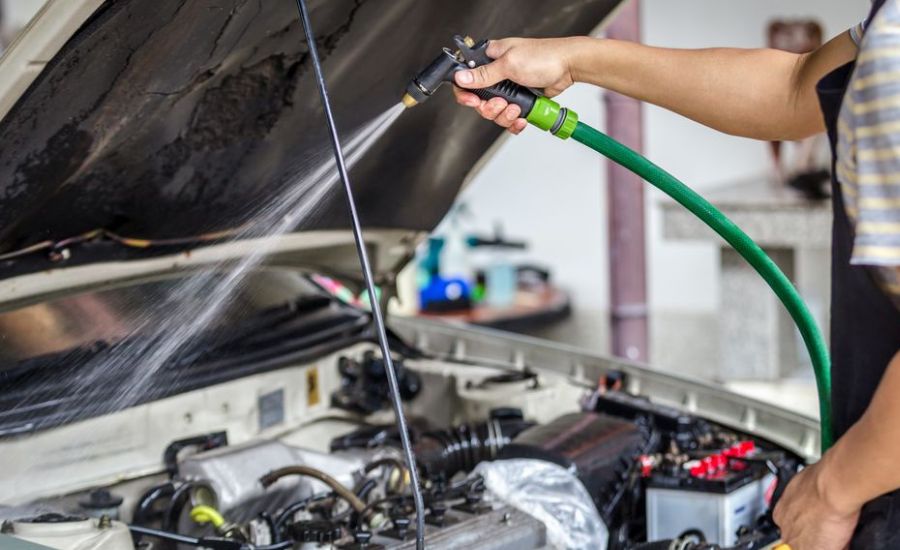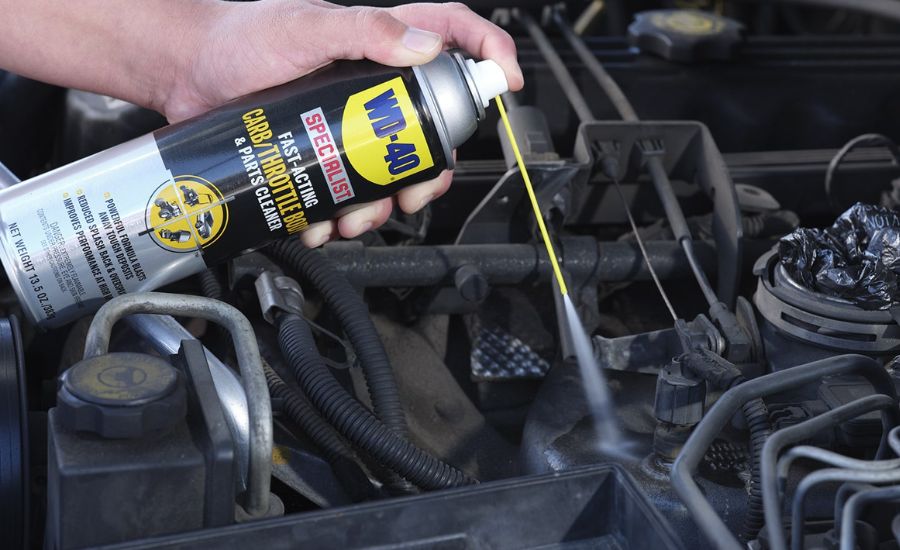In the realm of automotive care, maintaining a pristine power steering system is paramount. The power steering fluid coursing through its veins is the lifeblood, ensuring a seamless dance between the steering wheel and the tires.
This article delves into the intricacies of clean power steering fluid — why it matters, signs of trouble, and the “art of its rejuvenation”.
From the subtle hum of a well-lubricated system to the unsavory leaks or residues, every nuance will be explored. Join us on this journey through the veins of your vehicle, understanding the nuances of hydraulic fluid, and mastering the alchemy that keeps your steering smooth and responsive.

Comprehension of power steering fluid
Comprehension of the intricacies of power steering fluid is key for maintaining a healthy car. The power steering reservoir plays a pivotal role within the comprehensive operational framework of the directional system.
Any signs of hydraulic lubricant leaks demand immediate attention to prevent potential damage.
Performing a power steering fluid flush periodically ensures that the system operates smoothly. When adding new power steering fluid, it’s essential to use the correct type for your vehicle.
Brake cleaner spray is a useful tool to remove power steering fluid from exposed areas like spark plugs.
Taking care of the hydraulic lubricant is as vital as maintaining other automotive fluids to ascertain peak operational efficacy and preclude any concomitant issues in the steering systems.
Significance of clean hydraulic lubricant
Clean power steering fluid is paramount for the peak operational efficacy of your automobile’s hydraulic system. It guarantees smooth operation, forestalls power steering fluids leaks, and guards against potential damage to exposed engine components.
Regularly replacing old fluid with new, using appropriate cleaning agents like brake cleaner or degreasers, is essential.
Contaminants like dirt and old oil can compromise the fluid’s effectiveness. To maintain a healthy power directional system, routine checks of the liquid level and quality are crucial.
A well-maintained power steering reservoir contributes to the overall longevity and efficiency of your car’s engine.
Signs of contaminated hydraulic lubricant
Assisted steering, a crucial aspect of vehicle control, relies on clean hydraulic lubricant. Detecting issues is vital. Look for leaks around the power steering reservoir, signaling potential contamination. Exposed spark plugs covered in dirt might indicate fluid leaks reaching the engine.
Address this promptly to prevent damage. Inspect the fluid level and color; if it resembles motor oil or is unusually dark, contamination may be present.
Human error or using the wrong fluid can cause this. Regular checks and prompt action ensure a smooth, well-lubricated hydraulic lubricant system, preventing complications down the road.

How to check hydraulic lubricant cleanliness?
Checking the cleanliness of аssisted steering fluid involves inspecting the reservoir for any signs of contamination.
Ensure the reservoir cap is tightly sealed to prevent exposure to external elements. Use a clean cloth to wipe the dipstick and check for any discoloration or foreign particles.
If the fluid appears murky or there are visible contaminants, it might be time for a fluid change. Avoid exposing the reservoir to debris, and if cleaning is necessary, use a degreaser solution sparingly.
Regular monitoring of the fluid level and appearance helps prevent potential issues, ensuring the power directional system functions optimally.
Step-by-step guide to cleaning hydraulic lubricant
In the process of refreshing the power steering fluid, start by locating the power steering reservoir. Make sure the car engine is off, and the exposed spark plugs are protected.
Remove the reservoir cap, exposing the hydraulic lubricant.
Use an engine degreaser solution to clear away all the accumulated dirt. Use a pressure washer to thoroughly clean the reservoir, taking caution to avoid any chemical reaction with engine oil remnants.
Once cleaned, carefully fill the reservoir with new fluid, ensuring the fluid level aligns with manufacturer specifications.
This step-by-step guide mitigates the risk of hydraulic lubricant contamination, reducing the chances of operator error in the maintenance process.
Selecting the appropriate cleansing agents
Selecting the appropriate cleaning solutions for your аssisted power steering reservoir is crucial. Avoiding power steering fluid leaks and maintaining the health of your car engine requires careful consideration.
When choosing cleaning products, opt for a degreaser compound that won’t harm the hydraulic lubricant. Be cautious not to expose spark plugs or use engine oil as a substitute.
Using a pressure washer, eliminate all accumulated dirt from the power steering reservoir cap and surrounding areas. Remember, a fresh fluid application is necessary after cleaning to prevent any adverse chemical reactions.
Preventing operator error during this process ensures your hydraulic lubricant system operates smoothly with a healthy fluid level.

Tools needed for hydraulic lubricant cleaning
In the quest for cleaning power steering fluid, certain tools are indispensable. Begin with a pressure washer to eliminate all the dirt around the power steering reservoir. When accessing the engine, a degreaser compound is vital to clear away contaminants.
Take care not to expose the spark plugs during this process. To replenish the system, a new hydraulic lubricant is required, ensuring a chemical reaction doesn’t occur. Human error should be avoided, especially when handling the reservoir cap.
Having engine oil for lubrication purposes completes the arsenal needed for this meticulous task of maintaining a healthy hydraulic lubricant system.
Frequency of hydraulic lubricant cleaning
The regularity of cleaning the power steering fluid is pivotal for maintaining optimal performance.
Consistent inspection of the аssisted power steering reservoir prevents issues like power steering fluid leaks, ensuring a smooth and efficient directional system.
Regular checks become a safeguard against potential complications, contributing to the longevity and reliability of the аssisted steering components.
Remembering to inspect the hydraulic lubricant at appropriate intervals is akin to providing a health check for your vehicle, addressing concerns before they escalate, and preserving the integrity of the steering systems.
Consequences of contaminated hydraulic lubricant on the system
Contaminated power steering fluid can have detrimental effects on the entire system. When the power steering reservoir is filled with impurities, it might lead to compromised performance and potential leaks.
These issues escalate when a power steering fluid leak occurs, impacting the system’s efficiency.
Regular maintenance is crucial to prevent these problems, ensuring a smooth and reliable power steering operation.
Risks of ignoring power steering fluid operation
Ignoring power steering fluid maintenance poses significant risks to your automobile. Without adequate supervision, the power steering system, including the pump and power steering reservoir, might be compromised.
Using carb cleaner on the affected area is crucial for preserving the integrity of most vehicles’ power steering systems.
A well-maintained power steering system guarantees the longevity of crucial components such as the pump and power steering reservoir, preventing issues that may arise from contamination or fluid degradation.

How to forestall power steering fluid contamination?
To preserve the immaculacy of the power steering fluid, a vigilant modus operandi becomes imperative. Systematically scrutinizing the power steering reservoir and expeditiously mitigating any manifestations of a power steering fluid leak can obviate conundrums associated with contamination.
Regular checks ensure the fluid remains in optimal condition, sustaining the effectiveness of the аssisted directional system.
Frequent myths about power steering fluid cleaning
Dispelling misconceptions about power steering fluid cleaning is crucial for automobile owners. One frequent myth involves the belief that the power steering reservoir is a self-contained system that doesn’t require regular attention.
Another myth suggests that a power steering fluid leak is a minor issue, while, in reality, it can lead to significant problems if left unaddressed. Understanding the truth behind these myths forestalls proper sustentation and permanence of the power steering system.
Pro vs. DIY power steering fluid cleaning
When considering the power directional system, there’s a distinct contrast between relying on professionals and opting for a DIY approach.
The power steering reservoir demands attention, especially when dealing with potential predicaments like power steering fluid leaks.
The decision between professional expertise and personal endeavors hinges on understanding the intricacies of this crucial automotive system.

Conclusion
Preservation of pristine power steering fluid is crucial for the pinnacle of vehicular efficacy. Conducting routine examinations of the power steering reservoir and expeditiously remedying indications of power steering fluid seepage significantly contribute to the seamless functionality of the system.
Preserve the integrity of your vehicle’s steering system by adhering to endorsed maintenance practices and ensuring the power steering fluid remains uncontaminated.
FAQ
What can I use to clean power steering fluid off my engine?
Use a gentle degreaser to eliminate power steering fluid residue without causing harm to your engine constituents.
Is it better to have clean or dirty power steering fluid?
It is preferable to have a clean power steering fluid as it guarantees the optimal operational efficacy and protracted sustainability of the steering system.
Do you have to clean out old power steering fluid?
Certainly, purging antiquated power steering fluid is imperative to avert deleterious contaminants and uphold the optimal operational efficacy of the steering system.
What will clean power steering fluid?
Clean power steering fluid is efficacious in guaranteeing smooth steering operation, preventing wear, and enhancing overall vehicle performance.
How do you clean old power steering fluid?
To clean the old power steering fluid, drain the existing fluid, flush the system with new fluid, and ensure proper disposal of the old fluid.

